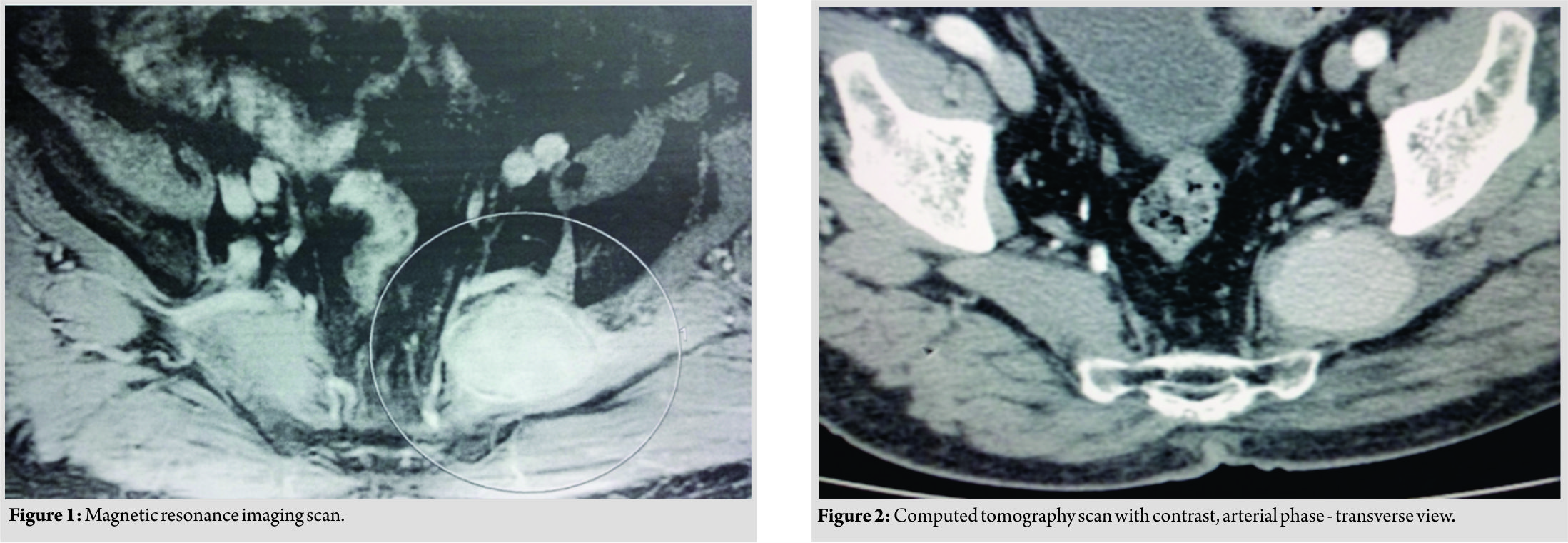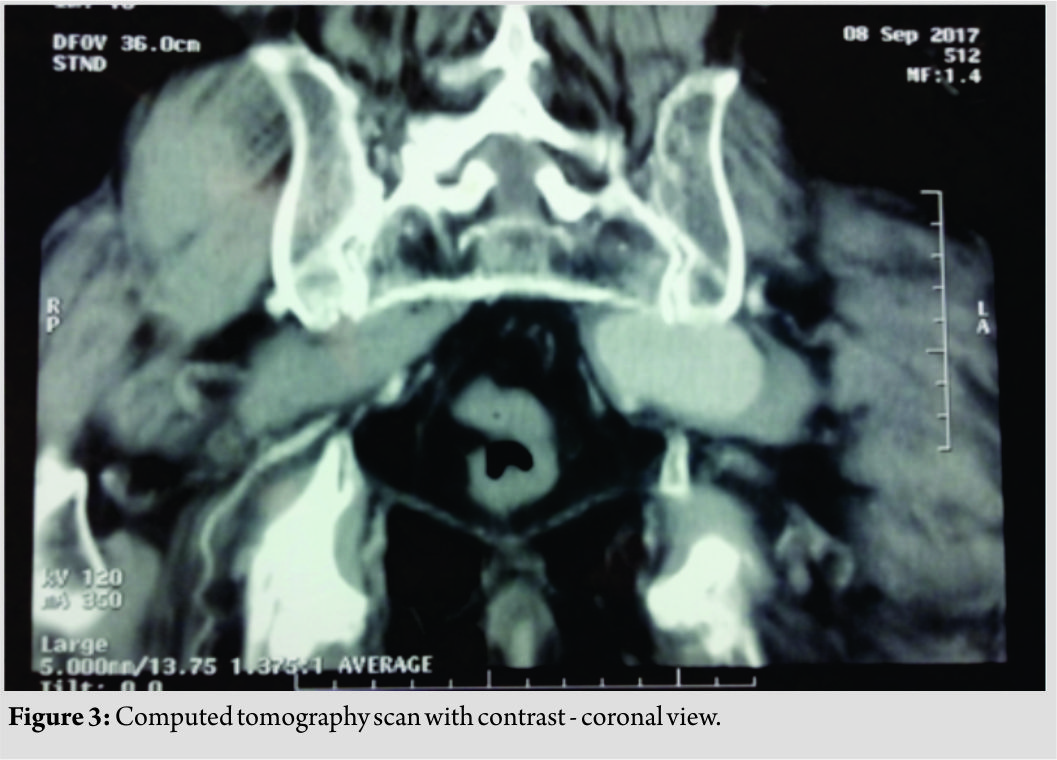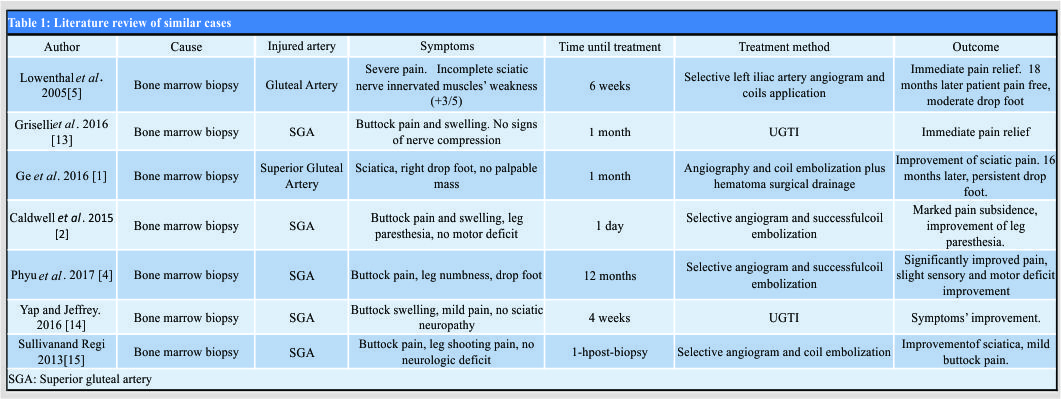[box type=”bio”] Learning Point for the Article: [/box]
Gluteal artery pseudoaneurysm post bone marrow biopsy is a rare extraspinal cause of sciatic nerve palsy and diagnosing this lesion is crucial to offer the patient the appropriate treatment and achieve a good outcome.
Case Report | Volume 8 | Issue 4 | JOCR July – August 2018 | Page 74-77| Ioannis M. Stavrakakis, George E. Magarakis, George Liodakis, Emmanouil Tavlas, Dimitrios K. Tsetis. DOI: 10.13107/jocr.2250-0685.1168
Authors: Ioannis M. Stavrakakis[1], George E. Magarakis[1], George Liodakis[2], Emmanouil Tavlas[3], imitrios K. Tsetis[4]
[1]Department of Orthopaedics and Traumatology, General Hospital Agios Nikolaos, Crete, Greece,
[2]Department of Radiology, General Hospital Agios Nikolaos, Crete, Greece,
[3]Department of Vascular Surgery, University Hospital of Heraklion, Crete, Greece,
[4]Department of Radiology, University Hospital of Heraklion, Faculty of Medicine, University of Crete, Greece.
Address of Correspondence:
Dr. Ioannis M. Stavrakakis,
Department of Orthopaedics and Traumatology,Locum Consultant of Trauma and Orthopaedics, General Hospital Agios Nikolaos,Crete, Greece.
Email: i.m.stavrakakis@gmail.com
Abstract
Introduction: Sciatic nerve radiculopathy can present as a result of intraspinal or extraspinal causes. Intraspinal disorders can be disk hernia, spinal trauma, tumors, or infection, whereas extraspinal cause representsa disorder outside the lumbar spine. A gluteal artery (GA)false aneurysm can potentially compress the sciatic nerve and causes radiculopathy, with subsequent motor and sensory deficits. This condition can result mainly from trauma or infection, but it can also be iatrogenic.
Case Report: We report a case of an 85-year-old male with a left sciatic nerve palsy as a result of a superior GA pseudoaneurysm post bone marrow biopsy (BMP). A short review of the literature regarding this topic is presented as well. Only a small number of similar cases are reported in the literature.
Conclusion: This case report emphasizes on the high suspicion index that the clinician should have managing a patient who suffers from sciatic nerve palsy with a history of a previous procedure around the pelvis’ area, such as BMP.
Keywords: Pseudoaneurysm, bone marrow biopsy, sciatica.
Introduction
Bone marrow biopsy (BMP) is considered to be a relatively safe procedure with a reported complication rate around 0.05–0.08%[1,2] including hematoma, infection, nerve damage, and gluteal artery (GA) pseudoaneurysm. GA false aneurysm can present as a painful, pulsatile mass on the buttock, and nerve compression symptoms such as leg radiating pain and sciatic nerve palsy [3,4,5].It is common the fact that a patient with lower limb radiculopathy following an iatrogenic incident may present much later [6]. We report a case of an 85-year-old patient, who presented to our department with a left buttock excruciating pain and the left sciatic nerve palsy, 8 weeks after BMP. The patient was referred to a tertiary center, where he was treated successfully with an ultrasound-guided thrombin injection (UGTI).
Case Report
An 85-year-old patient presented to our department reporting pain over his left buttock, radiating to his left leg with concomitant left drop foot and gait disturbances for approximately 4-week time. The patient mentioned that 2months ago he underwent a left-sidedBMP, which was required because of a suspected plasmacytoma found in the nasopharyngeal area. Immediately after the BMP, the patient felt severe pain on the left buttock radiating to his left leg, which he was given oral painkillers for. 4 weeks later, the patient developed the left drop foot and significant gait disturbances along with the left buttock pain. For another 4weeks, the patient was treated with medications for lumbar radiculopathy such as gamma-aminobutyric acid agonists, oral steroids, nonsteroidal anti-inflammatory drugs, and painkillers. As there was no improvement, the patient visited our department for further evaluation and management. He had a medical history of hypertension, hyperlipidemia, chronic obstructive pulmonary disease, diabetes mellitus type II, and coronary artery disease, which he was on aspirin for. On examination, there was tenderness palpating his left buttock as well as a mild swelling in the same area. Straight leg raising test was positive at 30°,and there was hypesthesia in the distribution area of the sciatic nerve. Severe muscle weakness on the left tibialis anterior, extensor hallucislongus, and peroneal tendons (0/5) was identified as well. The patient was systemically well, afebrile, with normal infection markers and hemoglobin 12.3. Given the history of the patient, a differential diagnosis between an intraspinal or extraspinal cause of sciatic nerve palsy was considered. Thus, a magnetic resonance imaging (MRI) scan of the lumbar spine and the pelvis, using intravenous contrast, was requested. Spine MRI revealed a moderate left L3-L4 intraforaminal disc hernia, which could hardly explain the symptoms of the patient. Pelvis MRI revealed a relatively large soft tissue mass (4.5cm× 3.2cm × 3cm) next to the left piriformis muscle, compressing the left sciatic nerve (Fig. 1).
This mass could be either a hematoma or a pseudoaneurysm, considering the previous BMP. To distinguish those two entities, a computed tomography (CT) scan with intravenous contrast of the pelvis was performed, which revealed a left superior gluteal artery (SGA) false aneurysm (Fig. 2 and 3). The patient was referred to the department of vascular surgery of a tertiary center for further evaluation and treatment. Initially, the patient underwent a left internal iliac artery selective angiography, which did not manage to identify the specific arterial branch from where the pseudoaneurysm originated. The next day a percutaneous UGTI was performed, which succeeded to exclude the aneurysm from circulation. The success of the procedure was confirmed by a Doppler ultrasound which showed no arterial flow inside the pseudoaneurysm. At present, 3-week post-procedure, the patient reports significant relief in terms of pain, but still, no improvement of the drop foot is noticed. His follow-up regarding the sciatic nerve function will continue.
Discussion
Vascular abnormalities of the pelvis are of a great interest as they can be potentially life threatening due to rupture and severe hemorrhage, or they can cause distal embolization or compression of adjacent structures, such as nerves, resulting in nerve palsy. Thus, diagnosis of these conditions is crucial, to offer the patient an effective treatment. They are distinguished in true aneurysms and false aneurysms (pseudoaneurysm). True aneurysms have all three arterial walls intact, whereas pseudoaneurysms lack of a complete arterial wall [12]. GA pseudoaneurysms are rare conditions, which can develop as a result of trauma, infection, and iatrogenic. Fractures of the pelvis [7] orpenetrating injuries [11]are the most common traumatic events prone to cause a GA pseudoaneurysm. It has been described though even after a blunt injury around the gluteal area [8]. Iatrogenic causes of pelvic pseudoaneurysm involve surgeries around the pelvis (such as total hip replacement[9], orthopedic internal fixation[4], lumbar disc surgery[6]), transvaginal ultrasound-guided follicle aspiration[3], radiation therapy[6], and BMP. A few number of cases of a pelvic false aneurysm due to iliac crest trephine biopsy are described in the literature (Table 1). To the best of our knowledge, only eight cases are reported in the English literature with seven of them involving the superior GA andin one is mentioned as GA pseudoaneurysm [5] (Table 1).In addition, this is the third reported case treated successfully with UGTI. Griselli et al. and Yap and Jeffrey described a successful treatment of GA pseudoaneurysm using UGTI[13,14]. Non-invasive imaging tools to detect pseudoaneurysms includeultrasonography (Doppler ultrasound scan), which is less effective for deep lesions, CT angiography,and MRI scan. MRI is a safer examination in terms of no radiation used. It is also less nephrotoxic than CT scan with contrast. High clinical suspicion index is required, as a simple CT scan, without contrast could diagnose falsely the lesion as a soft tissue tumor, guiding the management to an unnecessary biopsy, which can carry the risk of severe hemorrhage [4]. Diagnostic method of choice in such cases is selective internal iliac artery angiogram, during which a simultaneous coil embolization of the pseudoaneurysm is possible [12]. Goal of treatment is the exclusion of the pseudoaneurysm from the circulation. Methods to achieve that are either endovascular (coil embolization and stent application) or ultrasound-guided percutaneous injection of cast-forming agents such as thrombin [12]. The last technique was successful in our case. The patient reported immediate pain relief and there was no arterial flow demonstrated on the Doppler ultrasound post-procedure. Drop foot remains though, we are expecting no more than partial sciatic nerve recovery, considering the outcome of similar cases described in the literature.
Conclusion
Our case report tends to highlight an SGA pseudoaneurysm as a potential extraspinal cause of sciatica and sciatic nerve palsy, especially if a traumatic or iatrogenic incident is described around the buttock area. The clinician needs to be very careful, not to miss the diagnosis, as this condition can be life threatening, or it can lead to a significant disability due to permanent loss of nerve function. Thus, sciatica post-BMP, although rare, it can happen and requires thorough clinical examination and further imaging with Doppler ultrasound, MRI, or CT scan with contrast of the pelvis and selective angiography if necessary. Having the correct diagnosis, the appropriate treatment can be applied to the patient. In case endovascular coil embolization fails to treat the lesion, UGTI is a good alternative.
Clinical Message
Diagnosing an extraspinal cause of sciatic nerve palsy can be very challenging. It is very important though to find the cause of nerve compression to offer the patient the appropriate treatment. History of previous medical intervention and thorough physical examination, as well as proper imaging examinations lead to correct diagnosis.
References
1. Ge PS, Ng G, Ishaque BM, Gelabert H, de Virgilio C. Iatrogenic pseudoaneurysm of the superior gluteal artery presenting as pelvic mass with foot drop and sciatica: Case report and review of literature. VascEndovascSurg 2010;44:64-8.
2. Caldwell IR, Buckley BT, Rajagopal R, Doocey R, Pemberton L. Traumatic superior gluteal artery pseudoaneurysm following bone marrow biopsy. Int Med J 2016;46:374-5.
3. Yurtseven T, Zileli M, Göker EN, Tavmergen E, Hoşcoşkun C, Parildar M. Gluteal artery pseudoaneurysm, a rare cause of sciatic pain: Case report and literature review.J Spinal Disord Tech2002;15:330-3.
4. Phyu W, Zaw T, Park JK, Chang M, Lee HY. Endovascularmanagement of posttraumatic and iatrogenic large pelvic pseudoaneurysms following biopsy: Casereport.Radiol Case Rep2016;12:102-7.
5. Lowenthal RM, Taylor BV, Jones R, Beasley A. Severepersistentsciaticpain and weakness due to a gluteal artery pseudoaneurysm as a complication of bone marrow biopsy.J Clin Neurosci2006;13:384-5.
6. Choi I, Im SB, Kim BT, Shin WH. Radiculopathy caused by internal iliac artery pseudoaneurysm managed with endovascular embolization.J Korean Neurosurg Soc2007;42:484-6.
7. Sousa CM, Silva LF, Rodrigues ME, Félix A, Alpoim B, Marques P, et al. Spontaneous resolution of pseudoaneurysm of an internal iliac artery branch in a multiple trauma patient with a pelvic fracture: Clinical caseRev Bras Ortop 2015;46:87-90.
8. Babu A, Gupta A, Sharma P, Ranjan P, Kumar A. Blunt traumatic superior gluteal artery pseudoaneurysm presenting as gluteal hematoma without bony injury: A rare case report.Chin J Traumatol2016;19:244-6.
9. Shoenfeld NA, Stuchin SA, Pearl R, Haveson S. The management of vascular injuries associated with total hip arthroplasty. J Vasc Surg 1990;11:549-55.
10. Mahallati H, Owen RJ, Brunet WG, So CB. Therapeutic embolization of a pseudoaneurysm of the superiorglutealartery occurring as a complication of bone marrow biopsy: Casereport.Can Assoc Radiol J1999;50:265-7.
11. Singh V, Sharma H, Maini L. Inferiorglutealartery pseudoaneurysm mimicking gluteal abscess.Indian J Surg2007;69:257-9.
12. Jesinger RA, Thoreson AA, Lamba R. Abdominal and pelvicaneurysms and pseudoaneurysms: Imaging review with clinical, radiologic, and treatment correlation.Radiographics2013;33:E71-96.
13. Griselli F, Calvagna C, Sgorlon G, Zamolo F, D’OriaM, Chiarandini S, et al. Management of an iatrogenicpseudoaneurysm of the superior gluteal artery by percutaneous ultrasound-guided thrombin injection: A case report.Ann Vasc Surg2017;38:317, e9-317, e11.
14. Yap WT, Jeffrey RB. Sonographic Diagnosis Of A Superior Gluteal Artery Arteriovenous Fistula And Pseudoaneurysm After Bone Marrow Biopsy.J Ultrasound Med2016;35:1104-6.
15. Sullivan CM, Regi JM. Pseudoaneurysm of the superior gluteal artery following bone marrow biopsy. Br J Haematol 2013;161:289-91.
 |
 |
 |
| Dr. Ioannis M. Stavrakakis | Dr. George E. Magarakis | Dr. Dimitrios K. Tsetis |
| How to Cite This Article: Stavrakakis I M, Magarakis G E, Liodakis G, Tavlas E, Tsetis D K. Sciatic Nerve Palsy due to a Superior Gluteal Artery Pseudoaneurysm PostBone Marrow Biopsy: A Case Report and Review of the Literature. Journal of Orthopaedic Case Reports 2018 Jul-Aug; 8(4):74-77 |
[Full Text HTML] [Full Text PDF] [XML]
[rate_this_page]
Dear Reader, We are very excited about New Features in JOCR. Please do let us know what you think by Clicking on the Sliding “Feedback Form” button on the <<< left of the page or sending a mail to us at editor.jocr@gmail.com







